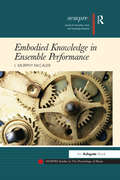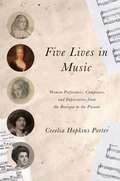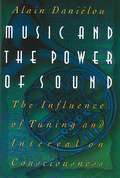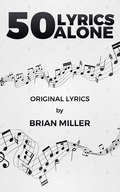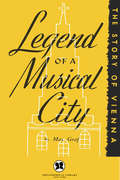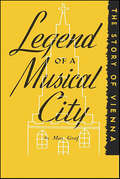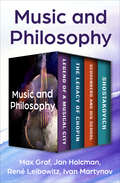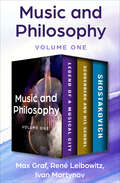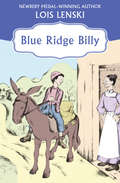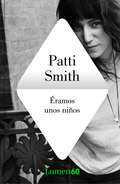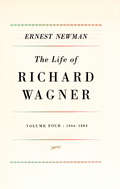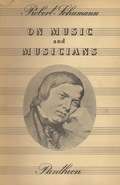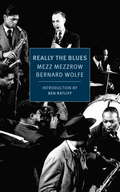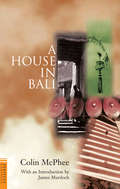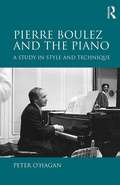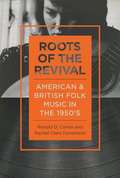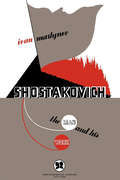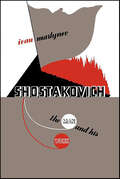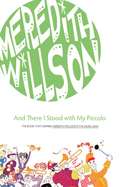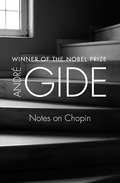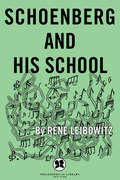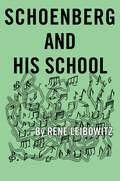- Table View
- List View
Embodied Knowledge in Ensemble Performance (Sempre Studies In The Psychology Of Music Ser.)
by J.Murphy McCalebPerforming in musical ensembles provides a remarkable opportunity for interaction between people. When playing a piece of music together, musicians contribute to the creation of an artistic work that is shaped through their individual performances. However, even though ensembles are a large part of musical activity, questions remain as to how they function. In Embodied Knowledge in Ensemble Performance, Murphy McCaleb explores the processes by which musicians interact with each other through performance. McCaleb begins by breaking down current models of ensemble interaction, particularly those that rely on the same kind of communication found in conversation. In order to find a new way of describing this interaction, McCaleb considers the nature of the information being shared between musicians during performance. Using examples from postgraduate ensembles at Birmingham Conservatoire as well as his own reflective practice, he examines how an understanding of the relationship between musicians and their instruments may affect the way performers infer information within an ensemble. Drawing upon research from musicology, occupational psychology, and philosophy, and including a DVD of excerpts from rehearsals and performances, Embodied Knowledge provides an holistic approach to ensemble research in a manner accessible to performers, researchers and teachers.
Five Lives in Music: Women Performers, Composers, and Impresarios from the Baroque to the Present
by Cecelia Hopkins PorterRepresenting a historical cross-section of performance and training in Western music since the seventeenth century, Five Lives in Music brings to light the private and performance lives of five remarkable women musicians and composers. Elegantly guiding readers through the Thirty Years War in central Europe, elite courts in Germany, urban salons in Paris, Nazi control of Germany and Austria, and American musical life today, as well as personal experiences of marriage, motherhood, and widowhood, Cecelia Hopkins Porter provides valuable insights into the culture in which each woman was active. Porter begins with the Duchess Sophie-Elisabeth of Braunschweig-Lueneberg, a harpsichordist who also presided over seventeenth-century North German court music as an impresario. At the forefront of French Baroque composition, composer Elisabeth-Claude Jacquet de La Guerre bridged a widening cultural gap between the Versailles nobility and the urban bourgeoisie of Paris. A century later, Josephine Lang, a prodigiously talented pianist and dedicated composer, participated at various times in the German Romantic world of lieder through her important arts salon. Lastly, the twentieth century brought forth two exceptional women: Baroness Maria Bach, a composer and pianist of twentieth-century Vienna's upper bourgeoisie and its brilliant musical milieu in the era of Gustav Mahler, Richard Strauss, Arnold Schoenberg, and Erich Korngold; and Ann Schein, a brilliant and dauntless American piano prodigy whose career, ongoing today though only partially recognized, led her to study with the legendary virtuosos Arthur Rubinstein and Myra Hess. Mining musical autographs, unpublished letters and press reviews, interviews, and music archives in the United States and Europe, Porter probes each musician's social and economic status, her education and musical training, the cultural expectations within the traditions and restrictions of each woman's society, and other factors. Throughout the lively and focused portraits of these five women, Porter finds common threads, both personal and contextual, that extend to a larger discussion of the lives and careers of female composers and performers throughout centuries of music history.
Music and the Power of Sound: The Influence of Tuning and Interval on Consciousness
by Alain DaniélouMusic has always been esteemed for its power to speak directly to our higher consciousness, a power founded in the purity of simple harmonic ratios. In this book, Alain Danielou traces the development of musical scales and tuning from their origins in both China and India, through their merging in ancient Greece, and on to the development of the Western traditions of modal and polyphonic music. Understanding these potent harmonic relationships offers a way for today's musicians to transcend the limitations of overly rationalistic music by drawing on its metaphysical roots.
50 Lyrics Alone
by Brian MillerEnclosed lyrics have all been compiled using memories of past and present genres. The author has compiled each set of lyrics to blend with a sound or rhythm 'in his head' at the time and hopes that anyone, even with only minimal musical knowledge, will upon reading any of the lyrics, be inspired to take up or sit at their musical instrument and strum, pluck, tinkle, thump or blow a tune and have absolute delight.The author himself has no musical background or training in music and does not play any type of musical instrument not even badly--but does enjoy music thoroughly. This book could prove to be the start of a whole new thoroughly enjoyable musical experience.
Bad Boy of Music
by George AntheilThe memoirs of George Antheil, 1900-1959. No musician has ever written memoirs such as these, until the much later work of Ned Rorem, perhaps partly because few musicians can write, and chiefly because no musician, not even the most wild-haired, has had a life like the one George Antheil is currently enjoying. Witty, glittering, packed full of the bizarre, these pages record the fabulous career of an extraordinary pianist, composer, and writer who got his introduction to music in plebeian Trenton when two innocent-looking old ladies covered up a jailbreak by thundering on the piano. After Trenton, nothing about George Antheil's life has been plebeian. Practicing the piano sixteen hours a day, he toured Europe, played French compositions in Germany, married a Hungarian in Paris, and there became a leader of Left Bank iconoclasts. In 1929 he returned to America for the performance of his "Ballet Mécanique" (scored for machines and airplane propeller), which caused a sensation among critics and sent him penniless back to Europe. In 1933 he returned again to America, where he led an even more checkered career, writing several books, magazine articles which have since become famous, and indulging his favorite hobby of, obviously, glandular criminology. Then he went to Hollywood, did the score for The Scoundrel, ran an advice-to-the-lovelorn column called "Boy Advises Girl," and composed a highly successful Fourth Symphony. If the mere framework of his life is colorful, the details are even more so. Like those of Oscar Levant's A Smattering of Ignorance, his pages are alive with famous personalities: the eccentric Stravinsky, James Joyce, Gertrude Stein, Stokowski, Dalí, Hedy Lamarr, to mention a few. But Bad Boy of Music is also a serious yet never obscure inside story of how it feels and what it takes to be a concert artist--a sober story abundant in illuminating and profound thoughts upon music and art in general.
Legacy of a Musical City
by Max GrafThe story of Vienna, the musical center of the world. Max Graf, the Nestor of Austrian music critics, relates in a fascinating manner his own recollections of life with Bruckner, Brahms, Strauss, and other immortals in the music world. The author has enjoyed the intimate friendships over the course of fifty years. He gives a delightful as well as a highly educational story of the development of Austrian music. From the table of contents: Studying with Anton Bruckner; Hours with Hugo Wolf; Recollections of Gustav Mahler; Memories of Johann Strauss; Talks with Johannes Brahms; Richard Strauss; Arnold Schoenberg; The Fight Pony Ballets; Music in Churches; The Dead City; Vienna of Tomorrow.
Legend of a Musical City: The Story of Vienna
by Max GrafA personal history of the world capital of classical music, written by the renowned Viennese musicologist and author of Composer and Critic. Max Graf shares his recollections of life with Anton Bruckner, Gustav Mahler, Johannes Brahms, Richard Strauss, Arnold Schoenberg, and other immortals of the music world. The influential musicologist, critic, and composer enjoyed intimate friendships with these men, who made musical history in his home city of Vienna. Bringing to life some of the most iconic figures in music, as well as the city of Vienna itself, Graf recounts a charming, personal, and highly educational story of Austria&’s musical legacy. &“Max Graf is not only an eminent historian and teacher, but a very adept writer; as a critic, he has shown keen judgment and objectivity.&” —Richard Strauss
Music and Philosophy: Legend of a Musical City, Legacy of Chopin, Schoenberg and His School, and Shostakovich
by Max Graf Jan Holcman René Leibowitz Ivan MartynovFour classic works that explore the lives and contributions of some of the greatest minds in classical music—essential reading for any classical music fan. In Legend of a Musical City, renowned Austrian music critic Max Graf shares his recollections of life with Anton Bruckner, Gustav Mahler, Johannes Brahms, Richard Strauss, Arnold Schoenberg, and other immortals of the music world. Bringing to life some of the most iconic figures in music as well as the city of Vienna itself, Graf recounts a charming, personal, and highly educational story of Austria&’s musical legacy. Jan Holcman&’s The Legacy of Chopin is a comprehensive study of the great composer&’s views on music, including pianism, composition, pedagogy, criticism, and more. Drawing on extensive research from a wide range of sources, Holcman provides essential historical and musicological context for Chopin&’s references and concepts, making his more esoteric ideas accessible to the general reader. In Schoenberg and His School, noted composer, conductor, and music theorist René Leibowitz offers an authoritative analysis of Schoenberg&’s groundbreaking contributions to composition theory and Western polyphony. In addition to detailing his subject&’s major works, Leibowitz also explores Schoenberg&’s influence on the works of his two great disciples, Alban Berg and Anton Webern. In Shostakovich: The Man and His Work, Ivan Martynov presents a compelling and intimate biography of this pioneering legend. Martynov draws on extensive research, including interviews and conversations with Shostakovich himself, as well as his own expertise in the field of musicology.
Music and Philosophy Volume One: Legend of a Musical City, Schoenberg and His School, and Shostakovich
by Max Graf René Leibowitz Ivan MartynovThese three essential volumes on classical music theory and history explore the lives and contributions of some of music&’s greatest minds.In Legend of a Musical City: The Story of Vienna, renowned Austrian music critic Max Graf shares his recollections of life with Anton Bruckner, Gustav Mahler, Johannes Brahms, Richard Strauss, Arnold Schoenberg, and other immortals of the music world. Bringing to life several iconic composers as well as the city of Vienna itself, Graf recounts a charming, personal, and highly educational story of Austria&’s musical legacy.In Schoenberg and His School, noted composer, conductor, and music theorist René Leibowitz offers an authoritative analysis of Schoenberg&’s groundbreaking contributions to composition theory and Western polyphony. In addition to detailing his subject&’s major works, Leibowitz also explores Schoenberg&’s impact on the works of his two great disciples, Alban Berg and Anton Webern. In Shostakovich: The Man and His Work, Ivan Martynov presents a compelling and intimate biography of this pioneering legend. Martynov draws on extensive research, including interviews and conversations with Shostakovich himself, as well as his own expertise in the field of musicology.
Blue Ridge Billy
by Lois LenskiA young boy dreams of music and sunshine in the Great Smoky Mountains As far as Billy is concerned, there's no sight more beautiful than the sun setting over the Blue Ridge Mountains. When the day is done, he sneaks away from his work to watch the sun go down. If his father knew, he would call Billy lazy, but Mama would understand. She knows life in the mountains is hard and that there's no point in living if a person can't take time to appreciate what he has. Billy dreams of the day when he can pick up his fiddle and sing the folk songs of his people. Until then, he will be content with the sun. This beautifully written novel tells a story of simple fun and irresistible pleasures in 1 of the most beautiful regions in the United States.
Christmas Carols (Little Golden Book)
by Corinne MalvernThis Little Golden Book collection of classic Christmas carols will have your family singing all season long! This festive Little Golden Book from 1946 is back in print for the first time in 40 years! Beautiful vintage illustrations bring to life sheet music and lyrics for beloved carols and hymns that families have sung together for many generations: "Away in a Manger," "Joy to the World," "Deck the Halls," and more. Perfect for placing on the piano, or to give to a child or a collector of the classic Little Golden Books, this book will be cherished each holiday season.
Éramos unos niños
by Patti SmithGANADOR DEL NATIONAL BOOK AWARD El libro icónico de Patti Smith, en el que cuenta su relación con Robert Mapplethorpe: un homenaje a la amistad cuyas páginas cargadas de vitalidad y humor nos devuelven el sabor de un Nueva York donde casi todo era posible. Fue el verano en que murió Coltrane... Los hippies alzaron sus brazos vacíos y China detonó la bomba de hidrógeno. Jimi Hendrix prendió fuego a su guitarra en Monterey... Fue el verano del amor. Y en aquel clima cambiante e inhóspito, un encuentro casual cambió el curso de mi vida: fue el verano en que conocí a Robert Mapplethorpe. Corría el mes de julio de 1967 y eran unos niños, pero a partir de entonces Patti Smith y Robert Mapplethorpe sellaron una amistad que solo acabaría con la muerte del gran fotógrafo, en 1989. De eso habla este espléndido libro de memorias, de la vida en común de estos artistas, los dos entusiastas y apasionados, que cruzaron a grandes pasos la periferia de Nueva York para llegar hasta el centro neurálgico del nuevo arte. Fue así que acabaron instalándose en el hotel Chelsea y se convirtieron en los protagonistas de un mundo hoy ya perdido donde reinaban Allen Ginsberg, Andy Warhol y sus chicos, y se creaban las grandes bandas de música que marcaron los años finales del siglo XX, mientras el sida hacía estragos. La crítica ha dicho:«Un relato conmovedor del afán de unos seres dispuestos a poner sus almas al servicio del arte, inspirados por Rimbaud, Dylan, Genet y otros nombres idolatrados.»Rafa Cervera, Babelia, El País «Patti Smith no solo es una gran artista, es una hechicera, es decir, alguien en contacto con otros niveles de la realidad.»William S. Burroughs «Patti Smith nos ha honrado con una obra maestra, una espléndida invitación a abrir un cofre de los tesoros que nunca antes se había abierto.»Johnny Depp «Este libro es tan íntegro y puro que supone un auténtico éxtasis.»Joan Didion «Patti Smith fue hace tiempo el heraldo salvaje de Rimbaud, pero el dolor la convirtió en un San Juan de la Cruz, una persona mística llena de misericordia.»Edmund White
Life of R Wagner Vol 4
by Ernest NewmanErnest Newman's four-volume Life of Wagner, originally published between 1933 and 1947, remains a classic work of biography. The culmination of forty years' research on the composer and his works (Newman's first Study of Wagner was first published in 1899), these books present a detailed portrait of perhaps the most influential, the most controversial and the most frequently reviled composer in the whole history of western music. Newman was aware that no biography can ever claim to be complete or completely accurate: 'The biographer can at no stage hope to have reached the final truth. All he can do is to make sure that whatever statement he may make, whatever conclusion he may come to, shall be based on the whole of the evidence available at the time of writing.' In this aim he triumphantly succeeds.Volume IV completes the story from 1866 to Wagner's death in 1883. It covers the composition of Die Meistersinger and Parsifal, the completion of the Ring, Wagner's marriage to Cosima Liszt von Bülow, and the building of Bayreuth.
On Music and Musicians
by Robert SchumannReviews of specific compositions are accompanied by Schumann's articles and epigrams on all aspects of music.
Really the Blues
by Ben Ratliff Mezz Mezzrow Bernard WolfeMezz Mezzrow was a Jewish boy from the slums of Chicago who learned to play the clarinet in reform school and pursued a life in music and a life of crime. He moved from Chicago to New Orleans to New York, working in brothels and bars, bootlegging, dealing drugs, getting hooked, doing time, producing records, and playing with the greats, among them Louis Armstrong, Bix Beiderbecke, and Fats Waller. Really the Blues, the jive-talking memoir that Mezzrow wrote at the insistence of, and with the help of, the novelist Bernard Wolfe, is the story of an unusual and unusually American life, and a picture of a man who moved freely across racial boundaries when few could or did, "the odyssey of an individualist. . . the saga of a guy who wanted to make friends in a jungle were everyone was too busy making money."
A House in Bali
by Colin McpheeThis is a book about passion, obsession and discovery in an amazing land, but also about the voyage of a highly talented composer and writer. A House in Bali remains one of the most remarkable books ever written about the fabled island of Bali. This classic book tells the story of Balinese culture through a history of Balinese music. First published in 1947, it tells the story of the writer and composer Colin McPhee's (1900–64) obsession with a music once unknown to the West, and of his journey to Bali to experience it firsthand. In 1929, the young Canadian– born musician chanced upon rare gramophone recordings of Balinese gamelan music which were to change his life forever. From that moment, he lived for the day when he could set foot on the island where the clear, metallic music originated. He was able to realize his dreams and spent almost a decade there during the 1930's. Music of Bali and dance, as McPhee discovered to his delight, are second nature to the Balinese, and his subsequent writings and compositions proved seminal in popularizing Balinese gamelan music in the West. InA House in Bali, McPhee unfolds a beguiling picture of a society long established, staggeringly poor in Western terms, but rich beyond belief in spiritual values and joy. The young composer writes about his discoveries of music in Bali and growing understanding of an astonishing culture where the arts are a prime preoccupation, and of the arts, music is supreme. Much has been written on Bali, but this classic work from 1947 remains the only narrative by a Western musician.
Pierre Boulez and the Piano: A Study in Style and Technique
by Peter O'HaganPierre Boulez's first piano pieces date from his youth, prior to his studies in Paris with Messiaen, and his subsequent meteoric rise to international acclaim as the leader of the musical avant-garde during the 1950s. His most recent published work is a solo piano piece, Une page d’éphéméride, written some sixty years after his first attempts at composition. The piano has remained central to Boulez's creative work throughout his career, and although his renown as a conductor has to some extent overshadowed his other achievements, it was as a performer of his own piano music that his practical gifts first found expression. Peter O'Hagan has given performances of various unpublished piano works by Boulez, including Antiphonie from the Third Sonata and Trois Psalmodies. In this study, he considers Boulez's writing for the piano in the context of the composer's stylistic evolution throughout the course of his development. Each of the principal works is considered in detail, not only on its own terms, but also as a stage in Boulez's ongoing quest to invent radical solutions to the renewal of musical language and to reinvigorate tradition. The volume includes reference to hitherto unpublished source material, which sheds light on his working methods and on the interrelationship between works.
Roots of the Revival: American and British Folk Music in the 1950s (Music in American Life)
by Rachel Clare Donaldson Ronald D CohenIn Roots of the Revival: American and British Folk Music in the 1950s, Ronald D. Cohen and Rachel Clare Donaldson present a transatlantic history of folk's midcentury resurgence that juxtaposes the related but distinct revivals that took place in the United States and Great Britain. After setting the stage with the work of music collectors in the nineteenth century, the authors explore the so-called recovery of folk music practices and performers by Alan Lomax and others, including journeys to and within the British Isles that allowed artists and folk music advocates to absorb native forms and facilitate the music's transatlantic exchange. Cohen and Donaldson place the musical and cultural connections of the twin revivals within the decade's social and musical milieu and grapple with the performers' leftist political agendas and artistic challenges, including the fierce debates over "authenticity" in practice and repertoire that erupted when artists like Harry Belafonte and the Kingston Trio carried folk into the popular music mainstream. From work songs to skiffle, from the Weavers in Greenwich Village to Burl Ives on the BBC, Roots of the Revival offers a frank and wide-ranging consideration of a time, a movement, and a transformative period in American and British pop culture.
Shostakovich
by T. Guralsky Ivan MartynovShostakovich: The Man and His Work is a rich and compelling biography of one of the most famous composers of all time. Author Ivan Martynov brings together extensive research, including interviews and conversations with Shostakovich himself, to shed light on the man behind the music. This edition was translated from Russian by T. Guralsky and includes a list of musical works.
Shostakovich: The Man and His Work
by Ivan MartynovA comprehensive biography of the twentieth-century Russian composer, exploring his life, music, and legacy—by a noted musicologist who knew him personally. Russian composer and pianist Dmitri Shostakovich is universally renowned as one of the most important figures of twentieth-century classical music. In Shostakovich: The Man and His Work, Ivan Martynov presents a rich and compelling biography of this pioneering legend. Martynov draws on extensive research, including interviews and conversations with Shostakovich himself, as well as his own expertise in the field of musicology, to shed light on the man behind the music.
And There I Stood with My Piccolo
by Meredith WillsonAnd There I Stood with My Piccolo, originally published in 1948, is a zesty and colorful memoir of composer Meredith Willson's early years--from growing up in Mason City, Iowa, to playing the flute with John Philip Sousa's band and the New York Philharmonic Orchestra, to a successful career in composing for radio and motion pictures in Hollywood. It was apparent to everyone, except maybe Willson himself, that he was on his way to something big.Lighthearted and inspiring, it is no surprise Willson's tales caught the attention of prominent Broadway producers. In 1957, just nine years after the publication of this book, The Music Man became a Broadway sensation, winning five Tony Awards, including Best Musical. Meredith Willson's musical comedy is to this day arguably the most produced and beloved musical in American culture.
Notes on Chopin
by André GideAn inspiring discourse on the power of music from one of the twentieth century&’s most important figures, André Gide André Gide, one of the great intellectuals of the twentieth century and a devoted pianist, invites readers to reevaluate Frédéric Chopin as a composer &“betrayed . . . deeply, intimately, totally violated&” by a music community that had fundamentally misinterpreted his work. As a profound admirer of Chopin&’s &“promenade of discoveries,&” Gide intersperses musical notation throughout the text to illuminate his arguments, but most moving is Gide&’s own poetic expression for the music he so loved. This edition includes rare pages and fragments from Gide&’s journals, which relate to Chopin and music.
Notes on Chopin
by André GideAn inspiring discourse on the power of music from one of the twentieth century&’s most important figures, André Gide André Gide, one of the great intellectuals of the twentieth century and a devoted pianist, invites readers to reevaluate Frédéric Chopin as a composer &“betrayed . . . deeply, intimately, totally violated&” by a music community that had fundamentally misinterpreted his work. As a profound admirer of Chopin&’s &“promenade of discoveries,&” Gide intersperses musical notation throughout the text to illuminate his arguments, but most moving is Gide&’s own poetic expression for the music he so loved. This edition includes rare pages and fragments from Gide&’s journals, which relate to Chopin and music.
Schoenberg and His School
by René Leibowitz Dika NewlinIn Schoenberg and His School, René Leibowitz performs a threefold task. He relates the music of Schoenberg and his followers to the age-old tradition of Western polyphony, of which, he says, it is but the latest product. He discusses, with numerous musical examples, all known major works of Schoenberg and of his two great disciples Alban Berg and Anton Webern. And, in the final section of the book, he considers what the tradition represented by these three men could bring to the future, if carried still further by the young composers of today. Contents: Prolegomena to Contemporary Music; Arnold Schoenberg: The Origins and Foundations of Contemporary Music; Alban Berg: The Awareness of the Past in Contemporary Music; Anton Webern: The Awareness of the Future in Contemporary Music; The Structure of Contemporary Musical Speech.
Schoenberg and His School
by René LeibowitzThe noted music theorist presents a brilliant and sweeping study of Schoenberg&’s compositions and his influence on the generations that followed. A pioneering composer and leader of the Second Viennese School, Arthur Schoenberg was one of the most important figures in twentieth-century classical music. In Schoenberg and His School, composer, conductor, and music theorist René Leibowitz offers an authoritative analysis of Schoenberg&’s groundbreaking contributions to composition theory and Western polyphony. In addition to detailing his subject&’s major works, Leibowitz also explores Schoenberg&’s influence on the works of his two great disciples, Alban Berg and Anton Webern. Leibowitz considers how the influences of all three men have, in turn, created new movements within contemporary music today.
